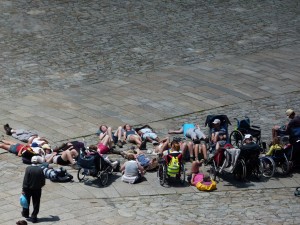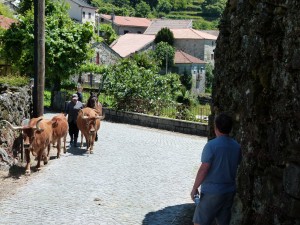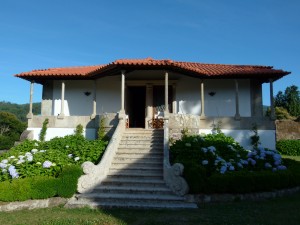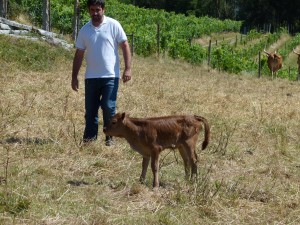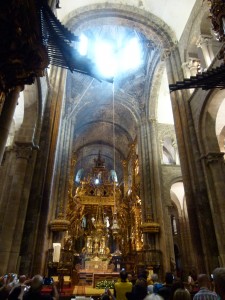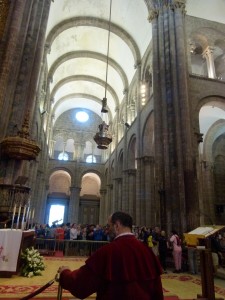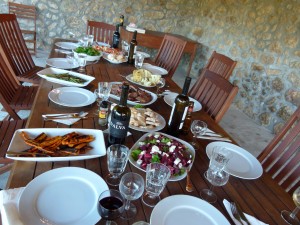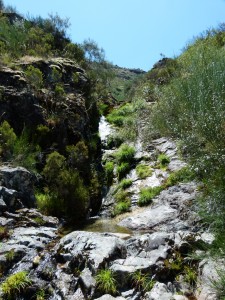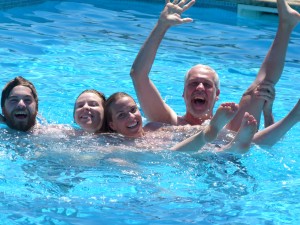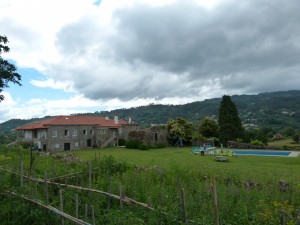A final report from Iberia
Posted on July 13, 2014
We arrived back in NH last night, exhausted from the hours of travel and the time difference, and happy to be back home. While we have a deep abiding passion for travel, coming home to one’s dog — who in truth greets us as excitedly when we return from the bathroom as from Spain — and the cat — who shows similar disinterest in either case –and a house full of our own things, is also one of the delights of being away. The coming back and the sense of rootedness in place.
Our travels through the Iberian Peninsula reminded us that the Old World has that sense of rootedness that is less present in American culture. We are too young, too in love with change and movement, and a country built of those who left. In Spain, we instead saw pilgrims walking the pilgrimage trails to Santiago de Compostela, often using ancient Roman routes, and wearing the scallop shell on their backpacks, a symbol of the pilgimmage.
One group completed the hundreds of miles, pushing disabled adults and teenagers in wheelchairs, and then collapsed in exchaustion in front of the maginficant cathedral.
We visited remote mountain towns in Portugal that looked and felt as they might have five hundred years ago, with livestock bring driven through the streets and
where local farmers still use these spooky looking granaries that look more like coffins.
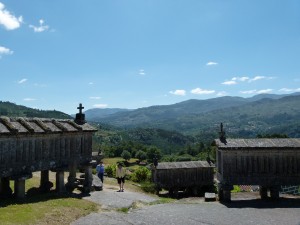
These “espigas” store corn cobs, are made from stone, and are clustered like a graveyard. And we found them sort of scary.
The lovely old house we rented was in a winery and farm and had been passed on through the generations.
In the middle of Vino Verde wine country, the estate still makes some 20,000 bottles a year and still uses people to crush grapes by foot. They keep an organic garden and raise cattle and we awoke one morning to a newborn calf that had been born in the night.
They let us name it and in the herd there is now officially a calf named SNOO.
Of course, the countryside of Portugal and Spain offer little career opportunity to young people and some of the mountain villages we visited seemed almost like ghost towns. The Economic Crisis, or “The Crisis” as everyone simply calls it, has taken a terrible toll and Portugal and Spain are not only seeing the villages empty, they are seeing their best and brightest leave for Germany, England, the US, and Australia to find work.
In Madrid, we saw people digging through dumpsters. In all the cities there were beggars, many at intersections approaching stopped cars. We tipped a waiter in a Braga restaurant and he chased me down, thinking I had misread the bill. When I mentioned this to the owner of the house, he was not surprised and said, “No one in Portugal tips anymore. We can’t afford it.” When I gave Lurdes, the housekeeper for the rental house, 100 Euros at the end of our stay, I thought she was going to cry. Things are tough and on our last day in Portugal the headlines screamed about the near failure of Banco Espirito Santo, the country’s second largest bank. Portugal and Spain have a long way to go before they return to some level of economic stability.
Converesly, it’s amazing to think about the richness of these countries at the height of their power in the 15th and 16th Centuries, when New World gold flooded their coffers. I said that most Iberian cathedrals are disappointing compared to their French and English counterparts, but the cathedral in Santiago was a dramatic exception and in its baroue splendor evoked what Spain once was in terms of wealth and power.
Wow. The reputed burial place of Saint James, one of the Apostles, this is where the pilgrims come having walked weeks and months across hundreds of miles. It’s worth the walk (or at least the drive, in our case). It was begun in 1075 and is magnificent and we arrived just in time for the midday Pilgrim’s Mass.
In the packed church, a mix of tourists and mostly pilgrims watched as eight red-robed tiraboleiros pulled on ropes and swung the world’s largest censer across the cathedral nave, almost to the ceiling, sending clouds of incense smoke throughout the church.
One theory is that it was used to cover the stink of hundreds of unwashed pilgrims. I know it helped cover the smell of the Spanish teenager next to me who had obviously used too much AXE body spray that morning, but in all events, it was pretty special to see it.
Highlights of the trip?
We like to eat and we like to cook and Spain’s cuisine is just a winner, expecially tapas and the delight of sampling small plates. Even the crappy little trucker’s stop in a dusty crossroads town was able to muster up an amazing tortilla. Portuguese food was less inspiring, but produce was fresh and we cooked at the villa, and evenings spent outside and chatting late into the night were some of our best.
And wherever we went we fed our addiction to Padron Peppers, the amazing sweet green peppers with the surprise hot ones (about 20% of any batch), fried in oil and covered with sea salt.
We went through platters of these. Calvin Trillin wrote glowingly about them some years ago in this piece (http://www.gourmet.com/magazine/2000s/2005/01/pepper) and mentions our friend, Juanita Martinez, who was along for part of this trip. It’s a great story. Meals were a highlight, as they always are, because they are so much more than about mere nourishment of the body.
The countryside. We spent a day navigating the perilous mountain curves of Portugal’s only national park, the Peneda-Geres, and were rewarded with amazing views, wild horses, and hidden waterfalls.
We had a picnic at a scenic overlook and in a day’s drive passed only a handful of cars in this remote northern end of the park. The farming country of the Minho was lush and had as many varieities of green as Ireland.
The list can go on and on: our bike ride around Madrid, an amazing dinner in a hidden away piazza in Salamanca, everyone acting like kids again in a spirited game of water polo (sort of), an impromptu
kitchen dance party during late night clean up, time in places and with art that lifted the spirit, and not living with any deadlines or schedule.
Mostly, as always, it was having extended time with dear friends, new friends, family, and our kids. We had some 17 people pass through the house while we were there. Some for just a night, others for two weeks. Everybody brought their A-game, jumping in to cook or clean, to be part of animated conversations, to share a story or a laugh. It is about as perfect as vacation can get and, in many ways, we plan vacations to create a setting and tone for days like those.
That’s why our best vacations have been when we have stayed rooted somewhere, doing day trips and explorations to be sure, but coming back to the one end-of-the-day gathering place where we once again come togther as family and friends. A lovely old stone farmhouse in rural Portugal this year gave us that gift.

